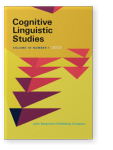Vol. 10:1 (2023) ► pp.57–84
Metonymy in the nomenclature of Japanese traditional colors
This paper offers a cognitive semantic analysis of 185 nominal-nominal compounds that are used to express Japanese traditional colors (e.g., budoo-nezumi [grape-rat] ‘plum purple’). It explores the types of nominals adopted into compounds, the components’ semantic relations, and the types of metonymy involved in the meaning construction. The most frequently found semantic relations of the two components of the compounds are: (i) color of the ‘right’ blended with color of the ‘left’, where both components are construed metonymically via whole for the part (e.g., budoo-nezumi [grape-rat] ‘plum purple’ is a blend of two colors: grey, expressed by nezumi ‘rat’ (whole), standing for the animal’s hair color (part), and dark purple, expressed by budoo ‘grape’ (whole), standing for the fruit’s skin color (part)); and (ii) color of the ‘left’, expressed by the X-iro [X-color] compound (e.g., kohaku-iro [amber-color] ‘amber’). While both components in the X-iro compounds are typically used literally, overall, 65% of the 185 compounds involve metonymy (whole for the part, action for result, among others), suggesting the important role played by metonymy in meaning construction of the compounds expressing Japanese traditional colors.
Article outline
- 1.Introduction
- 2.Data and framework
- 2.1Data and method
- 2.2Construction morphology
- 2.3Conceptual metonymy
- 3.Object-based compounds
- 3.1Characteristics of the right elements
- 3.2Characteristics of left elements
- 3.3Semantic relations between the left and right elements
- 3.3.1Color of the ‘left’
- 3.3.2Color of the ‘right’ blended with color of the ‘left’
- 3.3.3Color of the ‘right’ associated with a person expressed by the ‘left’
- 3.3.4Color of the ‘right’ whose range is delimited by the specification of the ‘left’
- 4.Event-based compounds
- 4.1Characteristics of the component nominals
- 4.2Semantic relations between the left and right elements
- 4.2.1Event with a focus on a dyer
- 4.2.2Event with a focus on ‘dyeing’
- 5.Results and discussion
- 5.1Types of nominals of the components
- 5.2Semantic relations of the components of compounds
- 5.3Metonymy
- 5.3.1Data distribution
- 5.3.2Metonymy in the meaning construction
- 6.Conclusion
- Acknowledgements
- Notes
-
References
